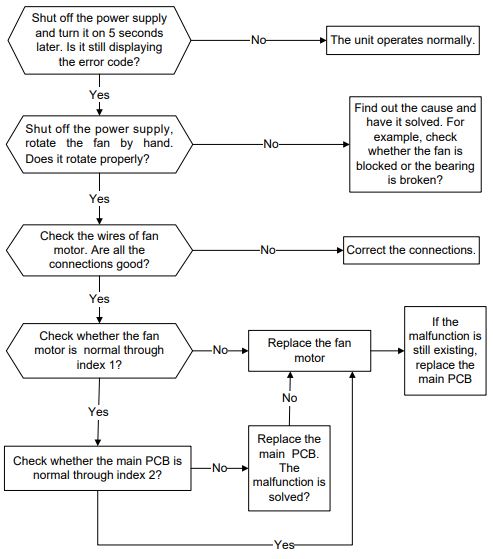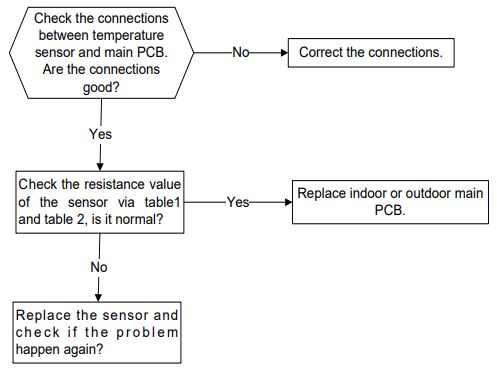
| Error Codes | Problem |
|---|---|
| E0 | EEPROM parameter error |
| E1 | Indoor / outdoor units communication protection |
| E2 | Zero-crossing signal error |
| E3 | Fan speed out of control |
| E5 | Open or short circuit of outdoor ambient or condenser temperature sensor |
| E6 | Open or short circuit of indoor room or evaporator temperature sensor |
| P0 | Inverter module (IGBT) over-strong current protection |
| P1 | Overvoltage or too low voltage protection |
| P2 | Temperature protection of compressor top. |
| P4 | Inverter compressor drive error |
| ☆ 1 time flash | E1 EEPROM parameter error |
| ☆ 2 times flash | E2 Zero-crossing signal detection error |
| ☆ 3 times flash | E3 Indoor fan speed has been out of control |
| ☆ 5 times flash | E5 Indoor room temperature sensor T1 open circuit or short circuit |
| ☆ 6 times flash | E6 Evaporator coil temperature sensor T2 open circuit or short circuit |
| ☆ 2 times flash | EC Refrigerant leakage detection |
Note: E4 & P3: Reserved function
TGM AC Troubleshooting

When troubles occur, please check the following points before contacting a repair company.
| Problem | Possible Causes | Solution |
|---|---|---|
| Poor Cooling Performance | Temperature setting may be higher than ambient room temperature | Lower the temperature setting |
| The heat exchanger on the indoor or outdoor unit is dirty | Clean the affected heat exchanger | |
| The air filter is dirty | Remove the filter and clean it according to instructions | |
| The air inlet or outlet of either unit is blocked | Turn the unit off, remove the obstruction and turn it back on | |
| Doors and windows are open | Make sure that all doors and windows are closed while operating the unit | |
| Excessive heat is generated by sunlight | Close windows and curtains during periods of high heat or bright sunshine | |
| Too many sources of heat in the room (people, computers, electronics, etc.) | Reduce amount of heat sources | |
| Low refrigerant due to leak or long-term use | Check for leaks, re-seal if necessary and top off refrigerant | |
| SILENCE function is activated(optional function) | SILENCE function can lower product performance by reducing operating frequency. Turn off SILENCE function | |
| The unit is not working | Power failure | Wait for the power to be restored |
| The power is turned off | Turn on the power | |
| The fuse is burned out | Replace the fuse | |
| Remote control batteries are dead | Replace batteries | |
| The Unit’s 3-minute protection has been activated | Wait three minutes after restarting the unit | |
| Timer is activated | Turn timer off | |
| The unit starts and stops frequently | There’s too much or too little refrigerant in the system | Check for leaks and recharge the system with refrigerant. |
| Incompressible gas or moisture has entered the system. | Evacuate and recharge the system with refrigerant | |
| The compressor is broken | Replace the compressor | |
| The voltage is too high or too low | Install a manostat to regulate the voltage | |
| Poor heating performance | The outdoor temperature is exetremtly low | Use auxiliary heating device |
| Cold air is entering through doors and windows | Make sure that all doors and windows are closed during use | |
| Low refrigerant due to leak or long-term use | Check for leaks, re-seal if necessary and top off refrigerant |
NOTE: If your problem persists after performing the checks and diagnostics above, turn o your unit immediately and contact an authorized service center.
TGM AC Diagnosis and Solution
- EEPROM parameter error diagnosis and solution (E1)
- Zero crossing detection error diagnosis and solution (E2)
- Indoor fan speed has been out of control diagnosis and solution (E3)
- Open circuit or short circuit of temperature sensors diagnosis and solution (E5,E6)
- Refrigerant Leakage Detection diagnosis and solution (EC)
EEPROM parameter error diagnosis and solution (E1)

EEPROM: a read-only memory whose contents can be erased and reprogrammed using a pulsed voltage.
Zero crossing detection error diagnosis and solution (E2)

Indoor fan speed has been out of control diagnosis and solution (E3)

Open circuit or short circuit of temperature sensors diagnosis and solution (E5,E6)

Refrigerant Leakage Detection diagnosis and solution (EC)

European Disposal Guidelines
This appliance contains refrigerant and other potentially hazardous materials. When disposing of this appliance, the law requires special collection and treatment. Do not dispose of this product as household waste or unsorted municipal waste.
When disposing of this appliance, you have the following options:
- Dispose of the appliance at designated municipal electronic waste collection facility.
- When buying a new appliance, the retailer will take back the old appliance free of charge.
- The manufacturer will take back the old appliance free of charge.
- Sell the appliance to certied scrap metal dealers.
Special notice
Disposing of this appliance in the forest or other natural surroundings endangers your health and is bad for the environment. Hazardous substances may leak into the ground water and enter the food chain.
Comments